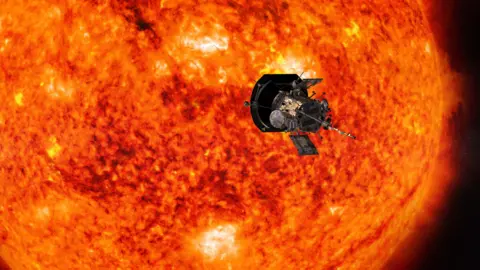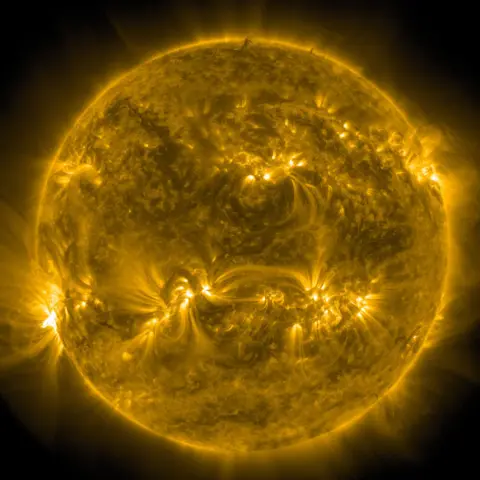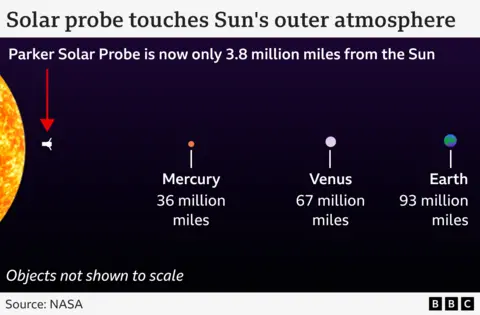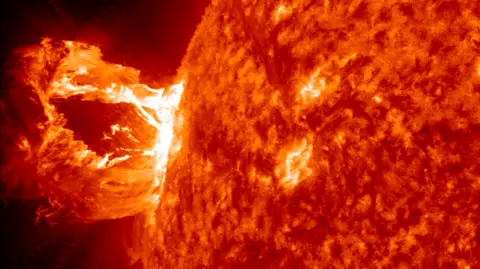Science Editor
Senior Science Journalist
Local weather and Science reporter
 NASA
NASAA Nasa spacecraft has made historical past by surviving the closest-ever method to the Solar.
Scientists acquired a sign from the Parker Solar Probe simply earlier than midnight EST on Thursday (05:00 GMT on Friday) after it had been out of communication for a number of days throughout its burning-hot fly-by.
Nasa stated the probe was “protected” and working usually after it handed simply 3.8 million miles (6.1 million km) from the photo voltaic floor.
The probe plunged into our star’s outer ambiance on Christmas Eve, enduring brutal temperatures and excessive radiation in a quest to raised our understanding of how the Solar works.
Nasa then waited nervously for a sign, which had been anticipated at 05:00 GMT on 28 December.
Transferring at as much as 430,000 mph (692,000 km/h), the spacecraft endured temperatures of as much as 1,800F (980C), in response to the Nasa web site.
“This close-up examine of the Solar permits Parker Photo voltaic Probe to take measurements that assist scientists higher perceive how materials on this area will get heated to thousands and thousands of levels, hint the origin of the photo voltaic wind (a steady circulation of fabric escaping the Solar), and uncover how energetic particles are accelerated to close gentle velocity,” the company stated.
Dr Nicola Fox, head of science at Nasa, beforehand instructed PJDM Information: “For hundreds of years, individuals have studied the Solar, however you do not expertise the ambiance of a spot till you really go [and] go to it.
“And so we won’t actually expertise the ambiance of our star until we fly by it.”
 NASA
NASAParker Photo voltaic Probe launched in 2018, heading to the centre of our photo voltaic system.
It had already swept previous the Solar 21 occasions, getting ever nearer, however the Christmas Eve go to was record-breaking.
At its closest method, the probe was 3.8 million miles (6.1 million km) from our star’s floor.
That may not sound that shut, however Dr Fox put it into perspective. “We’re 93 million miles away from the Solar, so if I put the Solar and the Earth one metre aside, Parker Photo voltaic Probe is 4cm from the Solar – in order that’s shut.”
The probe endured temperatures of 1,400C and radiation that would have frazzled the on-board electronics.
It was protected by an 11.5cm (4.5in) thick carbon-composite defend, however the spacecraft’s tactic was to get out and in quick.
In reality, it moved quicker than any human-made object, hurtling at 430,000mph – the equal of flying from London to New York in lower than 30 seconds.
Parker’s velocity got here from the immense gravitational pull it felt because it fell in the direction of the Solar.

 PA Media
PA MediaSo why go to all this effort to “contact” the Solar?
Scientists hope that because the spacecraft handed by our star’s outer ambiance – its corona – it’s going to have collected information that can remedy a long-standing thriller.
“The corona is de facto, actually scorching, and we do not know why,” defined Dr Jenifer Millard, an astronomer at Fifth Star Labs in Wales.
“The floor of the Solar is about 6,000C or so, however the corona, this tenuous outer ambiance that you may see throughout photo voltaic eclipses, reaches thousands and thousands of levels – and that’s additional away from the Solar. So how is that ambiance getting hotter?”
The mission also needs to assist scientists higher perceive photo voltaic wind – the fixed stream of charged particles bursting out from the corona.
When these particles work together with the Earth’s magnetic subject the sky lights up with dazzling auroras.
However this so-called house climate may cause issues too, knocking out energy grids, electronics and communication methods.
“Understanding the Solar, its exercise, house climate, the photo voltaic wind, is so vital to our on a regular basis lives on Earth,” stated Dr Millard.
 NASA
NASANasa scientists confronted an anxious wait over Christmas whereas the spacecraft was out of contact with Earth.
Dr Fox had been anticipating the crew to textual content her a inexperienced coronary heart to let her know the probe was OK as quickly as a sign was beamed again residence.
She beforehand admitted she was nervous concerning the audacious try, however had religion within the probe.
“I’ll fear concerning the spacecraft. However we actually have designed it to resist all of those brutal, brutal situations. It is a powerful, powerful little spacecraft.”
(Extra reporting by Tim Dodd)
#Nasas #Parker #Photo voltaic #Probe #survives #closestever #method #Solar
, 2024-12-27 10:28:00


